The project of aero-train engineer S.S. Waldner
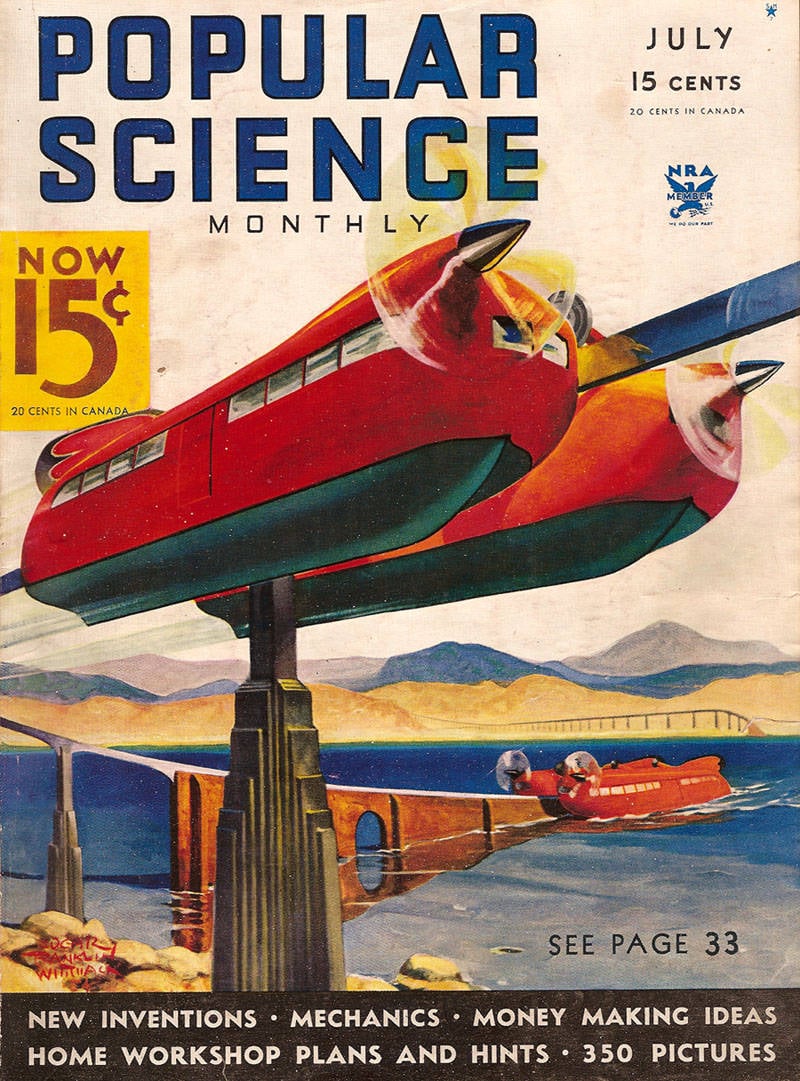
The author of the original idea was a self-taught engineer Sevastian Sevastyanovich Waldner. In 1915, he was drafted into the army, where he was taught to drive a car and carry out all the necessary maintenance work on equipment. S. Waldner showed great interest in various mechanisms and techniques, which eventually led to the emergence of several original projects. So, already in the second half of the tenths S. Waldner took part in the creation of promising high-speed armored rubber "Matval" and several other types of railway equipment. In the early twenties, the designer continued his research on the subject of high-speed vehicles, the result of which was the creation of a prototype of aero wagon.
Our achievements magazine in 1933 wrote that several incidents were the cause of the creation of a new project. The first of these occurred during the testing of the Matval car. This time, together with S. Waldner, FE was in the cab of the car. Dzerzhinsky. While driving at high speed, the armored rubber ran over a pickaxe, forgotten by someone on the tracks. The car jumped, but returned to the rails. Later S. Waldner almost knocked down a child walking along the railway tracks, but still managed to slow down in time. Finally, on July 24, 1921, on the way from Tula to Moscow, Valery Abakovsky, the aircraft of a design, derailed. Seven passengers from 22 died. Among the victims of the crash were the author of the project and party leader F.A. Sergeev (comrade Artem).
These cases forced S. Waldner and his colleagues to think about the safety of promising high-speed rail vehicles. After much deliberation and discussion, it was decided to abandon the use of existing railways. The operation of high-speed technology on lines not intended for it was associated with great risks. For this reason, the construction of special paths only for high-speed transport looked quite appropriate. Gradually formed and the appearance of a promising aero. He had to use a monorail and move with the help of an aircraft engine with a propeller.
Preliminary studies and calculations were made before the beginning of the thirties. In 1931, the engineers began to develop a full-fledged project, according to which it was supposed to build prototype prototypes, and then serial air trains. For the design of a promising transport, a special group was organized at the Central Institute of Structures of the People's Commissariat of Communications (CIS NKPS), later called the Waldner Aircraft Bureau. Over the next few years, the authors of the project managed to carry out a lot of various activities that could later change the system of freight and passenger transportation in the Soviet Union.
To ensure the required stability even at high speeds, S. Waldner developed a special monorail and chassis train design based on the idea of the so-called. stability triangle. New transport had to move along the truss monorail, the cross section of which was an isosceles triangle. At the upper apex of this triangle there was a main rail on which the train was supposed to rest. At the lower tops, it was proposed to mount additional support surfaces designed to stabilize the vehicle while driving.
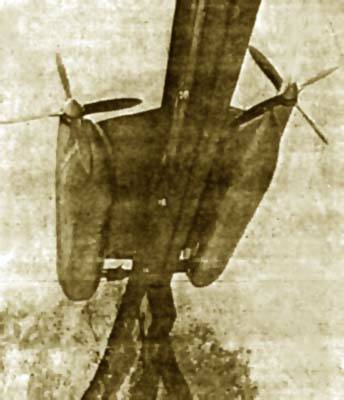 For keeping the train on the monorail answered running trolley. In its composition were used maxillary single pipe bushings. It is noteworthy that such units will be actively used on railway technology only in a few decades. In case of breakdown of the undercarriage, a ski was provided for in its design. Side slider trolleys should be located in the lower part of the airport. With the help of rubberized rollers, these units had to take on the lateral loads that arise when moving along curved sections of the path. On the existing schemes it is clear that three trolleys (one chassis and two runners) were proposed to be mounted on a common U-shaped frame. Thus, a rigid (with the exception of elastic suspension elements) design that is not prone to deformations or displacements should have been in contact with the triangular monorail.
For keeping the train on the monorail answered running trolley. In its composition were used maxillary single pipe bushings. It is noteworthy that such units will be actively used on railway technology only in a few decades. In case of breakdown of the undercarriage, a ski was provided for in its design. Side slider trolleys should be located in the lower part of the airport. With the help of rubberized rollers, these units had to take on the lateral loads that arise when moving along curved sections of the path. On the existing schemes it is clear that three trolleys (one chassis and two runners) were proposed to be mounted on a common U-shaped frame. Thus, a rigid (with the exception of elastic suspension elements) design that is not prone to deformations or displacements should have been in contact with the triangular monorail.It was proposed to include two (or more) U-shaped frames with carriages in the composition of the aeropod design by S. Waldner. They had to be movably connected to the train body. A hinge was provided in the upper part, and shock absorbers in the lower part, which reduce the deviation of the hull from the vertical when moving along curved sections of the track.
To ensure an optimal location of the center of gravity, it was proposed to use a body with a passenger cabin, divided into two parts. Passengers or cargo had to be in two elongated streamlined gondolas, connected in the upper part by two bridges. The latter should have the shape of a wing and form some lifting force, reducing the load on the undercarriage. In the lintel wings it was proposed to place the chassis frames. With this design, the center of gravity of the new aero-train was always well below the undercarriage, but higher than the side rails of the runner carriages. In combination with the chassis design and its shock absorbers, such a layout of the car promised high stability and stable behavior in all driving modes.
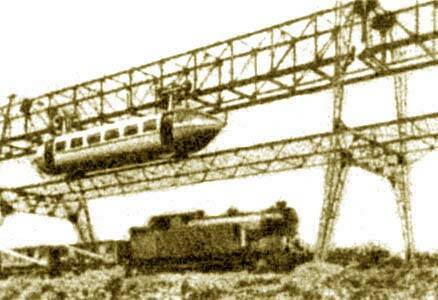 At the beginning of the thirties, the fastest rail transport was the so-called. aircars - car trunks with aviation engine and propeller. Such a power plant, which did not interact with wheels and rails, allowed to develop uniquely high speeds. For example, in the early twenties, the Abakovsky aircar could accelerate to 140 km / h. In the design of the S. Waldner air train, it was proposed to use a similar power plant.
At the beginning of the thirties, the fastest rail transport was the so-called. aircars - car trunks with aviation engine and propeller. Such a power plant, which did not interact with wheels and rails, allowed to develop uniquely high speeds. For example, in the early twenties, the Abakovsky aircar could accelerate to 140 km / h. In the design of the S. Waldner air train, it was proposed to use a similar power plant.Due to the use of two cargo-passenger gondolas, the idea to equip the aero-train with two separate propeller-engine groups located in the rear part of the hull. The power of the engines and the type of screws should be determined in accordance with other characteristics of the aero-train, primarily on the basis of the calculated curb weight and the required speed. For this reason, various types of aero trains had to be completed with different power units.
High speeds imposed specific requirements for braking systems. Traditional brakes using pressure pads could not provide an effective slowdown of the train without significant wear or even serious damage to its own design and wheel sets. For this reason, it was decided to use aerodynamic brakes. At the right moment, it was proposed to reduce the engine thrust or stop it altogether, as well as pull out special curtains from the hull, as they were called then. By correct and timely change of engine thrust and use of air brakes, it was possible to regulate the speed of the train while driving, as well as to brake it with acceptable efficiency.
At the preliminary stages of the project, different versions of aircrafts suitable for use in practice were considered. The proposed concept allowed in theory to build trains with a capacity of up to 250-300 passengers or several tens of tons of cargo. For example, the layout of the passenger train gondola with 80 seats for passengers has been preserved. Such a unit should have a length of 30,75 m and a width of about 1,8 m. The nasal compartment of the nacelle was given up for the driver’s cab, and the tail section for the placement of the engine and other necessary units. At the same time, the entire central section of the hull was occupied by a passenger cabin. To reduce the width of the gondola it was supposed to install passenger seats in a row near each side. Also in the gondola were provided sanitary facilities, etc.
The option of an aeropod on the 80 passenger seats was worked out by S. Waldner and his colleagues for use on lightly loaded areas. For lines with large passenger traffic it was supposed to build larger air trains with corresponding characteristics. It was planned to build a train with 300 seats on the line. With a total length of the order of 63 m, such a train was required to be made up of several carriage modules connected to each other. Such a large and heavy machine needed two 530 hp engines. Estimated maximum speed reached 300 km / h.
The calculated high speed of movement affected not only the structure of the aero train, but also the proposed control system. Since, while driving at a speed of 250-300 km / h, it was not necessary to rely on signs installed near the tracks, it was proposed to use appropriate instruments that determine the location of trains on the line and even control them automatically. Thus, the driver could monitor the console in the cockpit and determine its position on the route, as well as track the movement of other airplane trains. At the right time, he had to carry out acceleration or deceleration, and these procedures could be performed automatically. It was also possible to create a remote control system with which the dispatcher was to control the trains.
The proposed project of the aero-train looked extremely bold and unusual, but it was very interesting from the point of view of organizing mass transportation. The magazine “Our achievements” wrote that S. Waldner's train could significantly reduce the time to travel. So, on the way from Moscow to Tula should have gone about 50 minutes, a trip from Moscow to Leningrad - a little more than three hours. In addition to reducing the time on the road, the widespread introduction of airplanes, according to calculations, should have had another positive feature. The authors of the project considered that transferring even parts of passenger transportation to separate lines with aerial trains would free up railways for freight trains, increasing their carrying capacity for cargo by tens of percent. In addition, the possibility of creating freight monorail high-speed trains was considered.
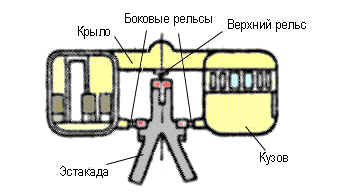 With all its advantages, the project of S. Waldner and his colleagues had one serious drawback - it existed only on paper. To consider the construction of the first monorail lines, it was required to conduct a complex of tests and determine the real possibilities of the proposed transport. At the beginning of the 1930s, specialists from several scientific organizations were involved in these works.
With all its advantages, the project of S. Waldner and his colleagues had one serious drawback - it existed only on paper. To consider the construction of the first monorail lines, it was required to conduct a complex of tests and determine the real possibilities of the proposed transport. At the beginning of the 1930s, specialists from several scientific organizations were involved in these works.High speed made special demands on the aerodynamics of a promising monorail train. For this reason, shortly after the start of work, TsAGI specialists were involved in the project. Together, TsAGI and TsIS employees managed to form a general body shape with the best characteristics. Based on existing materials and technologies, it was possible to provide good performance at speeds of the order of 200 km / h. In the future, it was planned to develop the form of gondolas and wings for airplane trains with higher speeds.
In 1933, the Waldner Air Traffic Bureau built the first prototype of a promising vehicle that was planned to be tested on a special track. The ground for testing was the Moscow park. M. Gorky, where they built all the necessary facilities. The main element of the test complex was a ring overpass with a length of 474 m with straight and curved sections. On the monorail was provided for the transmission of electricity to a small aeropot-prototype.
The reduced prototype of the S. Waldner aero-train had a length of about 2,5 m and a width of no more than 1 m. Due to its small size, the prototype received a simplified undercarriage with one undercarriage and two pairs of runner rollers. Two electric motors with propellers installed in the tail section of the side gondolas were used for movement. Electricity was supplied from the control panel through the rails. The outer contours of the prototype case corresponded to the forms of a full-fledged aero train. In addition, the prototype had the appropriate coloring with painted windows.
Despite the simplified design, the prototype was able to show the viability of the ideas and proposals used. The device successfully developed speed at the level of 120 km / h and confidently moved both along straight and curved sections of the path. At the same time on the curves of the body of the prototype bent noticeably, although the position of the chassis remained unchanged. The tests continued for several months, which allowed not only to collect all the necessary data, but also to reveal the real potential of the structure. So, in the winter of 1933-34 in Moscow there were heavy snowfalls, which led to disruption of the work of the trams. Nevertheless, even in such weather, the prototype of the aero train maintained the required stability and moved without any problems along the snow-covered monorail.
The management of the People's Commissariat for Communications familiarized with the test results and concluded that the project should continue. The employees of the Central Institute of Structures and S. Waldner were instructed to prepare new test sites. In the 1934 year, two objects were built at once, used in the development of an aero-train. At the Northerner station near Moscow, a life-size site with a monorail was built and tested. In addition, a new experimental track, 8 km long, appeared in Butovo, near Moscow.
During the tests at the new sites, both the first prototype and the new models of the aero train were used. Specialists continued to study the behavior of wheeled carts and other machine units at various speeds and sections of tracks.
The interest of the NCSP was expressed not only in the form of an order to continue the work. Already in 1934, the reconnaissance of a new monorail line, about 500 km in length, began, which was supposed to connect the cities of Tashauz (now Dashoguz) and Chardzhou (now Turkmenabat) of the Turkmen SSR. In addition, the question of the future construction of other monorail lines in other parts of the Soviet Union was considered.
In July, 1934, the American popular science magazine Popular Science, published an article about a new Soviet project and even posted a drawing of an aero-train on the cover. The submission claimed that the Soviet government was going to build three monorail lines with a total length of 332 miles (530 km) in Turkestan, which would cross deserts and rivers. Aeroports with a diesel-electric powerplant will be able to reach speeds of up to 180 miles per hour (about 290 km / h). Also, American journalists mentioned that the new Soviet aero-trains would cross the Amu Darya river about 1,25 miles wide (about 2 km) in a very interesting way: when they arrived at the shore, they would be able to go down the river and cross the monorail on the other side.
The project of the aeropod S. Waldner became famous not only in the USSR, but also abroad. All the works were accompanied by regular notes in the press; great hopes were pinned on the project. It was even planned to develop, build and test a prototype aero train with jet engines. However, in 1936, all work stopped. About 600 drawings, as well as a large number of other project documentation sent to the archive. For what reason this happened is not known for certain. Engineer B. Kachurin, who participated in the development of the project, later recalled that the project stopped due to certain circumstances not related to the essence of the proposed inventions. However, he did not specify what exactly was the reason for the termination of the project.
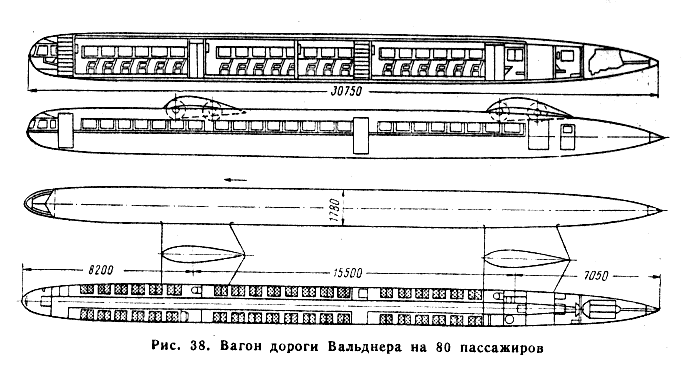
The available information about the project of S. Waldner's aero-train allows several assumptions about the possible reasons for its closure. For example, we can assume that the work stopped due to the identification of some technical problems that would not allow the use of new development in practice. However, there is no information on this subject - the project was considered successful and promising until its close. In addition, one may suspect a conspiracy with personal motives, as a result of which a new development has remained out of work.
Nevertheless, the most logical and plausible version seems to affect the features of passenger traffic in the thirties of the last century. At the beginning of the decade, several types of aircraft were the only high-speed passenger transport. However, passenger aircraft of that time could not boast of a large payload and high speed of flight. In addition, their number clearly did not satisfy the growing demand.
As an example, you can take the K-5 aircraft designed by K.A. Kalinin, in the thirties was the main vehicle of Aeroflot. 260 of such aircraft was built, which could carry only 8 passengers or 690 kg of cargo for a range of 960 km. The maximum flight speed was 206 km / h, cruising was about 25 km / h less. For comparison, the Waldner airport train, even in smaller versions, could carry 80 passengers at speeds above 250 km / h. Larger options for an aero-train looked even more interesting and promising, especially in comparison with existing passenger aircraft.
We should not forget that the thirties were a period of rapid development of aviation. In just a few years, maximum flight speeds and payloads have increased. The new aircraft were slowly but surely catching up on the characteristics of the Waldner airliner, which at that time had not yet reached practical use, since it was at the test and refinement stage. Finally, in 1935, the USSR acquired from the United States a license to manufacture the Douglas DC-3 aircraft, which later became the country's main air carrier.
The DC-3 and its Soviet version of the PS-84 / Lee-2 could carry up to three dozen passengers and reach speeds of up to 320 km / h (cruising 290 km / h). Thus, at least in terms of speed, the new aircraft was not inferior to the airplane train under development. At the same time, the plane did not need to build special complex trestles with a monorail and could use existing airfields.
Thus, it can be assumed that the continuation of the project of aero-train by engineer S.S. Waldner was hampered by the development of passenger aviation, which, yielding in one characteristics, was in the lead in others. As a result, probably, the management of the NKPS decided to abandon the promising, but not yet ready to use vehicle. Given the limited resources that did not allow to implement all interesting projects, such a failure seems a logical and logical ending.
After the closure of the project of aero-train SS Waldner and his colleagues engaged in the development of other types of railway equipment, as well as various components and assemblies for it. The subject of monorail transport and aero wagons was forgotten for some time, but after a few decades it was returned to it again.
On the materials of the sites:
http://semafor.narod.ru/
http://vlshmerling.narod.ru/
http://strangernn.livejournal.com/
http://blog.modernmechanix.com/
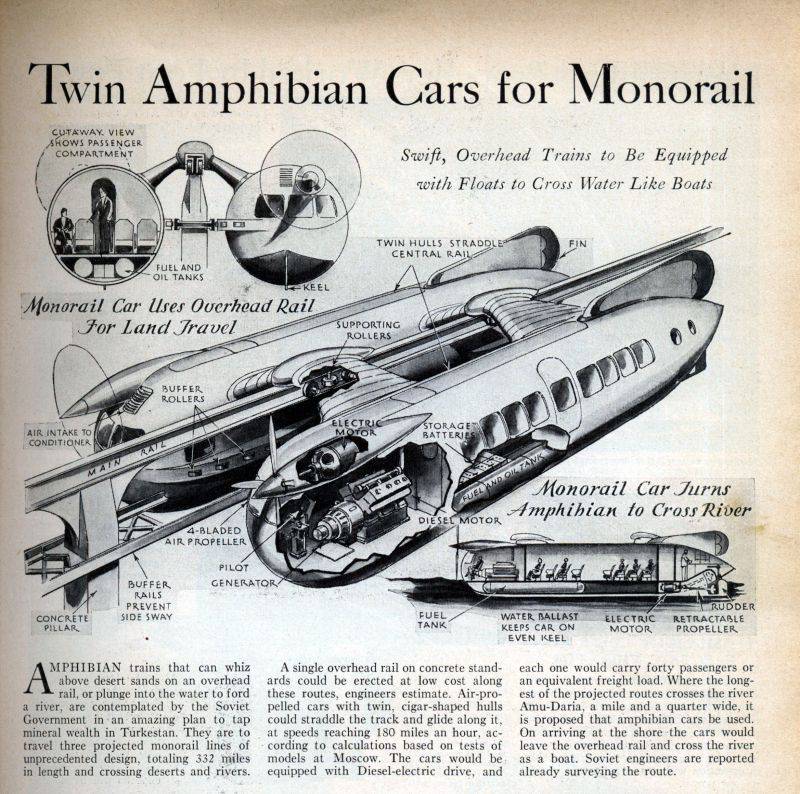
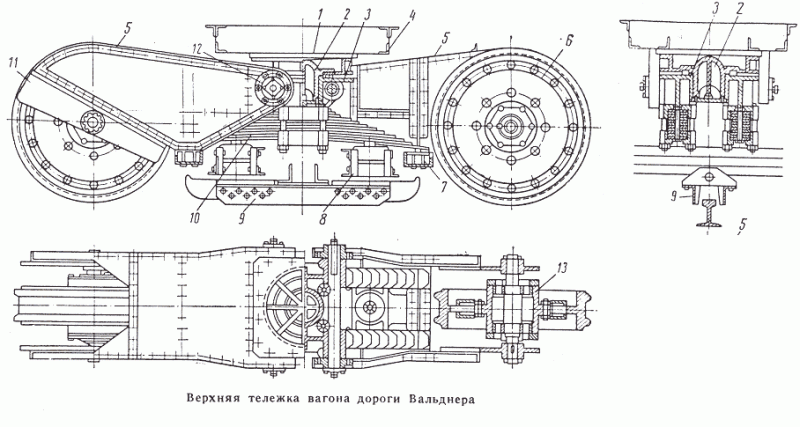
Information